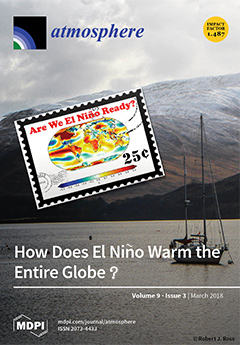Based on stable hydrogen and oxygen isotope data (δ
18O, δD) and meteorological observation data for complete hydrological annual precipitation from 2016 to 2017 in the monsoon marginal region of northern China (Fengxiang and Ningwu), the isotopic characteristics of precipitation and the
[...] Read more.
Based on stable hydrogen and oxygen isotope data (δ
18O, δD) and meteorological observation data for complete hydrological annual precipitation from 2016 to 2017 in the monsoon marginal region of northern China (Fengxiang and Ningwu), the isotopic characteristics of precipitation and the sources of water vapor in these two regions combined were studied. The results showed that δ
18O and δD values in the wet season (June through September) were higher than in the dry season (October to May of the following year) in Fengxiang and Ningwu. The intercept and slope of the meteoric water line in the two regions were somewhat low, revealing that the water vapor in the rainfall comes mainly from the tropical ocean. On a synoptic scale, significantly positive correlations among dry season precipitation, δ
18O, and temperature manifested temperature effects, but in the wet season, the temperature effect was not significant. On a monthly scale, a relationship did not exist between the change in trend of the average value of monthly weighted δ
18O in precipitation and the average temperature change value in the two regions. However, in the wet season, significantly negative relationships can be found between the average monthly weighted δ
18O in precipitation and rainfall amount, which indicated a remarkable rainout effect. Further investigation revealed that continuous precipitation made the values of δ
18O and δD more negative under the same source of water vapor (the rainout effect). Because the annual rainfall in the monsoon marginal region of Northern China is mainly made up of monsoon rainfall, the oxygen isotope index of geological and biological records, such as stalagmites and tree rings, which inherit meteoric water isotope information, can be used to reconstruct past rainfall changes in northern China.
Full article





